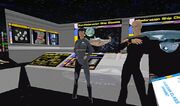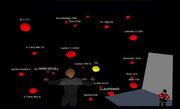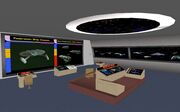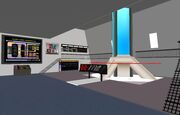
Avatars on the Main Deck of the Museum
The Star Trek Museum of Science is a 3D interactive museum found in the online virtual world Second Life.
Developed by Linden Lab, Second Life involves users interacting with its virtual environment, objects and each other, and taking on the appearance of user-modifiable avatars. The basic avatar is human in appearance, but avatars may be of either sex, have a wide range of physical attributes, and maybe clothed or otherwise customized to produce a wide variety of humanoid and other forms. While Second Life is sometimes referred to as a game, in general, it does not have points, scores, winners or losers, levels, an end-strategy, storyline or most of the other characteristics of online games. Users can visit this virtual world almost as if it were a real place. They explore, meet other residents, socialize, participate in individual and group activities, build, make and use objects and items, and buy items (virtual property) and services from one another. Second Life currently has over seven and a half million registered users worldwide.
The Star Trek Museum of Science provides Second Life visitors with Star Trek-related information, images, sound files and computer programs for users of Second Life on different aspects of the science of Star Trek - including starship design, engineering and computer technology to astronomy, cosmology, quantum physics, biology and materials science. It also allows visitors to interact directly with many in-game objects such as shuttlecraft, holodecks and replicators.
The stated aims of this Museum are to "promote greater awareness of the Star Trek universe among the general public, promote the study of the scientific and engineering technologies found in Star Trek and encourage interest in the real-life physics, astronomy, information technology and other sciences that are the foundation of those technologies."
How users interact[]

Users navigating the 3-D Starmap
To 'visit' this virtual Museum, users need to join Second Life (free memberships are available) and download its client program. Once in Second Life, users can use the program's search function and look for 'Star Trek Museum of Science', after which users are directly teleported to the location.
The Museum contains a number of displays, consoles and other objects, almost all of which will contain information in the form of Second Life 'Notecards'. To access information on any particular item, the user clicks on it and the relevant Notecard is automatically displayed on-screen. These Notecards display text related to the display and contain images that users can view by clicking on the texture icons embedded in the Notecard. Notecards may also be embedded with other Notecards. Some Notecards may also reference Internet URL addresses to relevant websites or files that can be downloaded (usually games, utility programs or Adobe Acrobat PDF files).
In addition, there are various objects in the Museum with which users can interact directly to produce sounds, video, materialize objects or initiate actions. For example, clicking on the tactical stations on the bridge of the Museum will produce audio clips for red alert, battle stations, shields and firing of weapons. The Museum's Planetarium displays 3D images of two-dozen real-life galaxies and nebulae, and there is a three-dimensional Star Map allowing visitors to navigate among objects representing some of the nearer stars to the Sun, with an accurate-to-scale perspective of the distances between them. The Museum's Shuttle Bay houses three Type 6 shuttlecraft which are available for visitors to fly themselves. A working Holodeck in the Museum can generate a selection of pre-defined holoprograms for users to interact in.
The Museum consists of three floors or decks - the Main Deck, the Engineering Deck and the Lower Deck. Each of those decks are, in turn, organized into various sections.
Main Deck[]

The Main Bridge of the Museum
The Main Deck of the Museum features a Bridge which houses various main and auxiliary consoles, stations and senior officers' chairs. These display information on Federation starship operations such as Conn, Ops, science station, engineering and tactical. The Viewer Screen on the bridge features a running slide show displaying images of different classes of Federation and non-Federation starship and shuttlecraft found in the Trek Universe, with consoles displaying detailed engineering schematics of many of these starships. Looking out the window in the Main Deck, visitors will see a formation of starships flying alongside. They include the Enterprise NX-01, Enterprise, NCC-1701-A, Enterprise-D, Enterprise-E, Voyager, Defiant, a Romulan Warbird and a Klingon Bird-of-Prey. Clicking on these starships will display notecards with information on the history, crew and capabilities of these starships. The Conference Room located immediately after the Bridge features a display of various Star Trek technologies that are being utilized today in 21st century Earth, with notecards and images on how, for example, the Communicator has evolved into the modern-day cell phone.
The Main Deck also houses an Astrometrics Lab with a Viewer Screen that has a running slide show displaying images of the various Star Trek galaxies, star systems, nebulae and other astronomical bodies found in the real-life universe. Consoles here not only explain their role in Star Trek but also their real-life features and astronomical information. A 3-D interactive exhibit demonstrating the different stellar and planetary classifications used in Starfleet, as well as the real-life astronomical classifications that form the basis for them. A Galactic Map of the Milky Way is also displayed, indicating where the various species and political entities in the Star Trek universe are located.
Engineering Deck[]

The Warp Core in Main Engineering
The Engineering Deck of the Museum features a M/ARA Mark II warp reactor, as well as consoles and displays on Starship technology such as warp drives and impulse engines, and their components. In addition to the theory and application of these technologies in the Trek universe, the displays also feature information on how these technologies relate to current real-life science and engineering. A Warp Theory station in Main Engineering features a structured series of exhibits looking at the fundamentals of the physics of faster-than-light travel. Beginning with classical physics concepts, the displays cover concepts such as Special Relativity, Twin Paradox, Causality Paradox, Doppler Shift, General Relativity, Subspace Fields, Warp Fields, Warp Propulsion and Warp Speed Charts.
The Computer Core of this Deck has information and displays on Star Trek computer technology - from the early duotronic systems of the USS Enterprise to the advanced bio-neural and positronic networks of later years. In addition, there are also a number of downloads of free systems utilities for your personal computer, including a Stardate calendar, Stardate clock, Klingon-speaking clock, LCARS-based text editors, personal information management systems, file managers, personal logs, Windows fonts and screensavers.
Three science labs are also found on this deck. The Exobiology lab has information on key animals, plants, micro-organisms and space-borne lifeforms in the Trek Universe. The Chemistry lab features Star Trek's Table of Elements and information on key materials used in the application of Star Trek technology. The Astrobiology lab looks at the real-world search for extra-terrestrial life, including the famous Drake Equation, the Arecibo Message and the Pioneer Plaque.
Lower Deck[]
This deck of the Museum has a number of recreational facilities such as a Games Room, cinema, radio room, art gallery and a lounge inspired by the Ten Forward of the Enterprise-D, and featuring a replicator that provides visitors with a selection of beverages from the Trek universe. Exiting this deck leads to a separate Culture Museum that provides information about the species who inhabit the Star Trek universe and explores their history, religion, art, philosophy, dining, and mating habits.
